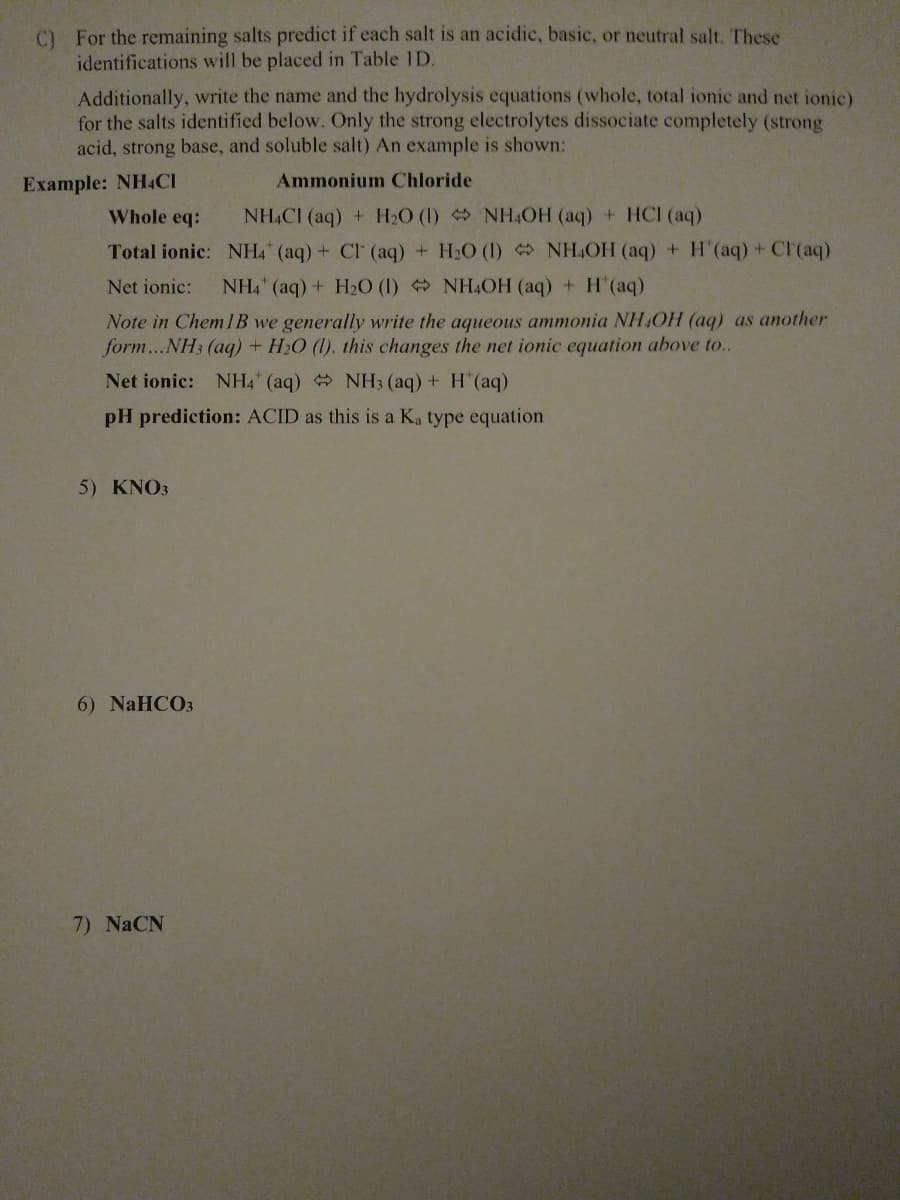C) For the remaining salts predict if each salt is an acidic, basic, or neutral salt. These identifications will be placed in Table 1D. Additionally, write the name and the hydrolysis equations (whole, total ionic and net ionic) for the salts identified below. Only the strong electrolytes dissociate completely (strong acid, strong base, and soluble salt) An example is shown: Example: NH4CI Ammonium Chloride Whole eq: NH.CI (aq) + H2O (1) NH4OH (aq) + HCI (aq) Total ionic: NH4 (aq) + CI (aq) + H2O (1) NH,OH (aq) + H'(aq)+ Cl(aq) Net ionic: NH, (aq) + H2O (1) NH,OH (aq) + H'(aq) Note in Chem 1B we generally write the aqueous ammonia NH4OH (aq) as another form...NH3 (ag) + H20 (1). this changes the net ionic equation above to.. Net ionic: NH4 (aq) NH3 (aq) + H'(aq) pH prediction: ACID as this is a Ka type equation 5) KNO3 6) NaHCO3 7) NaCN
Ionic Equilibrium
Chemical equilibrium and ionic equilibrium are two major concepts in chemistry. Ionic equilibrium deals with the equilibrium involved in an ionization process while chemical equilibrium deals with the equilibrium during a chemical change. Ionic equilibrium is established between the ions and unionized species in a system. Understanding the concept of ionic equilibrium is very important to answer the questions related to certain chemical reactions in chemistry.
Arrhenius Acid
Arrhenius acid act as a good electrolyte as it dissociates to its respective ions in the aqueous solutions. Keeping it similar to the general acid properties, Arrhenius acid also neutralizes bases and turns litmus paper into red.
Bronsted Lowry Base In Inorganic Chemistry
Bronsted-Lowry base in inorganic chemistry is any chemical substance that can accept a proton from the other chemical substance it is reacting with.

- Whole equation is to be written as the reaction between given salt with water resulting in the formation of acid and base.
- Ionic equation is the chemical equation which express electrolytes in an aqueous solution as dissociated ions.
- The net ionic equation is the chemical equation that shows only those elements, compounds and ions that are directly involved in the chemical reaction. Only strong electrolytes dissociates to ions.
- Spectator ions (same ion on both side) cancelled from ionic equation to get net ionic equation.
5) KNO3 - potassium nitrate
Whole equation - KNO3(aq) + H2O (l) ---> KOH (aq) + HNO3(aq)
Ionic equation - K+ (aq) + NO3-(aq) + H2O (l) ---> K+ (aq) + OH-(aq) + H+(aq) + NO3-(aq)
Net Ionic equation - H2O (l) ----> H+(aq) + OH-(aq)
Trending now
This is a popular solution!
Step by step
Solved in 2 steps









